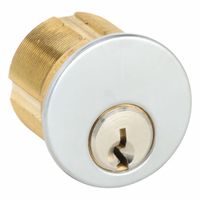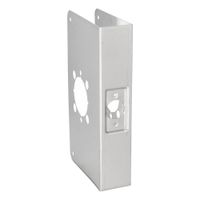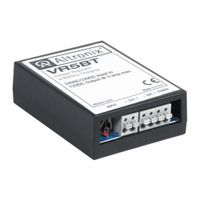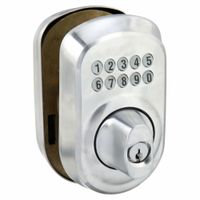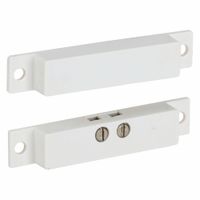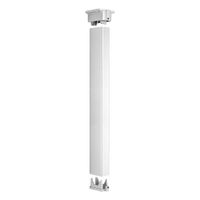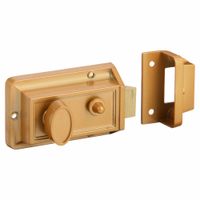Call +(254) 703 030 000 / 751 483 999 / 721 704 777
- Home
- Hardware
- Door Hardware
- Door Locks Strike Plates
.....Read More
Frequently Asked Questions
What is the best type of door lock for home security?
The best type of door lock for home security is a deadbolt lock, specifically a Grade 1 deadbolt. Grade 1 deadbolts are the highest standard set by the American National Standards Institute (ANSI) and offer superior protection against forced entry. These locks are designed to withstand a high level of force and are more resistant to picking, drilling, and other forms of tampering.
A single-cylinder deadbolt is commonly used for residential security. It requires a key to open from the outside but can be locked or unlocked from the inside with a thumb turn. For doors with glass panels, a double-cylinder deadbolt, which requires a key on both sides, can be more secure, though it may pose a safety risk in emergencies.
In addition to deadbolts, smart locks are becoming increasingly popular. They offer convenience and enhanced security features, such as remote access, keyless entry, and integration with home automation systems. Some smart locks also provide activity logs and alerts, allowing homeowners to monitor who enters and exits their home.
For optimal security, consider a lock with a reinforced strike plate and a door frame that can withstand force. High-security locks with patented keyways can prevent unauthorized key duplication.
Ultimately, the best lock for home security combines robust physical security with modern technology, tailored to the specific needs and vulnerabilities of the home.
How do I install a strike plate for a deadbolt?
1. **Gather Tools and Materials**: You will need a screwdriver, chisel, drill, drill bits, pencil, measuring tape, and the strike plate with screws.
2. **Mark the Position**: Close the door and turn the deadbolt to mark where it hits the door frame. Use a pencil to mark the top and bottom of the bolt on the frame.
3. **Align the Strike Plate**: Position the strike plate on the door frame, aligning it with the pencil marks. Ensure the center of the strike plate aligns with the center of the deadbolt.
4. **Outline the Strike Plate**: Trace around the strike plate with a pencil to mark where you need to chisel.
5. **Chisel the Mortise**: Use a chisel to carefully remove wood from the outlined area. The depth should match the thickness of the strike plate so it sits flush with the door frame.
6. **Drill Holes for the Deadbolt**: Drill a hole in the center of the mortise for the deadbolt to pass through. Ensure the hole is deep enough for the bolt to extend fully.
7. **Pre-drill Screw Holes**: Place the strike plate back in position and mark the screw holes. Pre-drill these holes to prevent the wood from splitting.
8. **Install the Strike Plate**: Position the strike plate in the mortise and secure it with screws using a screwdriver. Ensure it is tightly fastened and flush with the door frame.
9. **Test the Deadbolt**: Close the door and test the deadbolt to ensure it extends and retracts smoothly into the strike plate. Adjust if necessary.
10. **Final Adjustments**: If the deadbolt does not align perfectly, adjust the strike plate position slightly or enlarge the bolt hole as needed.
What are the benefits of keyless access deadbolt locks?
Keyless access deadbolt locks offer several benefits:
1. **Convenience**: They eliminate the need for physical keys, reducing the hassle of carrying, losing, or forgetting them. Users can enter their homes using a code, fingerprint, or smartphone app.
2. **Enhanced Security**: Many keyless locks offer advanced security features such as anti-tamper alarms, auto-locking, and temporary access codes for guests, enhancing overall home security.
3. **Access Control**: Homeowners can easily manage who has access to their property by assigning unique codes to different users. This is particularly useful for granting temporary access to service providers or guests.
4. **Remote Access**: Smart keyless locks can be controlled remotely via smartphone apps, allowing users to lock or unlock doors from anywhere, monitor access logs, and receive notifications about entry attempts.
5. **Durability**: Without mechanical keys and keyholes, keyless locks are less prone to wear and tear, reducing maintenance needs and extending the lock's lifespan.
6. **Integration with Smart Home Systems**: Many keyless locks can be integrated with smart home systems, allowing for automation and synchronization with other devices like security cameras, lights, and alarms.
7. **Customizable Features**: Users can customize settings such as auto-lock timers, access schedules, and alert preferences to suit their lifestyle and security needs.
8. **Aesthetic Appeal**: Keyless locks often have a modern design that can enhance the aesthetic appeal of a home, offering a sleek and contemporary look.
9. **Emergency Access**: In case of emergencies, keyless locks can provide quicker access compared to fumbling with keys, which can be crucial in urgent situations.
Overall, keyless access deadbolt locks offer a blend of convenience, security, and modern technology, making them an attractive option for homeowners seeking to enhance their home security systems.
How do I re-key a lock without replacing it?
To re-key a lock without replacing it, follow these steps:
1. **Purchase a Re-keying Kit**: Obtain a re-keying kit specific to your lock brand. These kits include pins, tools, and instructions.
2. **Remove the Doorknob or Lock Cylinder**: Use a screwdriver to remove the screws on the doorknob or lock faceplate. For deadbolts, remove the screws on the interior side.
3. **Extract the Lock Cylinder**: Once the knob or faceplate is off, use a cylinder removal tool (often included in the kit) to extract the lock cylinder.
4. **Open the Cylinder Plug**: Insert the current key into the lock and turn it slightly to the right or left. Use a plug follower (from the kit) to push the plug out of the cylinder, ensuring the pins and springs don’t fall out.
5. **Remove Old Pins**: With the plug out, remove the old pins from the plug. They are small, colored metal pieces.
6. **Insert New Pins**: Using the new key, insert it into the plug. Match the new pins from the kit to the key’s cut pattern. Each pin corresponds to a specific cut on the key.
7. **Reassemble the Lock**: Once the new pins are in place, carefully slide the plug back into the cylinder using the plug follower to keep the pins and springs in place.
8. **Reinstall the Lock**: Place the cylinder back into the lock housing. Reattach the doorknob or faceplate using the screws you removed earlier.
9. **Test the New Key**: Insert the new key and ensure it turns smoothly. If it doesn’t, recheck the pin alignment.
10. **Secure Everything**: Once confirmed, tighten all screws and ensure the lock is securely in place.
This process allows you to change the key that operates the lock without replacing the entire lock mechanism.
What is the purpose of an electric strike in a locking system?
An electric strike is a critical component in an access control system, designed to enhance security and convenience in locking mechanisms. Its primary purpose is to allow remote or automated control over the locking and unlocking of a door. Installed in the door frame, an electric strike replaces the fixed strike plate used in traditional locks. It works in conjunction with various types of locks, such as cylindrical, mortise, or rim locks.
The electric strike is equipped with a movable keeper, which holds the latch or bolt in place when the door is closed. When an authorized signal is received, typically from an access control system like a keycard reader, keypad, or intercom, the electric strike releases the keeper, allowing the door to be opened without manually turning the lock. This mechanism provides several advantages:
1. **Security**: Electric strikes enhance security by integrating with access control systems, ensuring that only authorized individuals can unlock the door. They can be configured for fail-safe (unlocked when power is lost) or fail-secure (remains locked when power is lost) operation, depending on security needs.
2. **Convenience**: They allow for remote unlocking, which is particularly useful in high-traffic areas or for individuals with mobility challenges. This feature is also beneficial in emergency situations, where doors can be unlocked quickly and efficiently.
3. **Integration**: Electric strikes can be integrated with other security systems, such as surveillance cameras and alarm systems, providing a comprehensive security solution.
4. **Versatility**: They are suitable for various door types and materials, making them adaptable to different architectural and security requirements.
Overall, the purpose of an electric strike is to provide a secure, efficient, and flexible solution for controlling access to buildings and rooms, enhancing both security and user convenience.
How do electromagnetic locks work?
Electromagnetic locks, or maglocks, operate using the principles of electromagnetism to secure doors. They consist of two main components: an electromagnet and an armature plate. The electromagnet is typically mounted on the door frame, while the armature plate is attached to the door itself.
When electrical current flows through the electromagnet, it generates a magnetic field. This magnetic field attracts and holds the armature plate tightly against the electromagnet, effectively locking the door. The strength of the magnetic field, and thus the holding force of the lock, depends on the amount of current supplied and the number of wire coils in the electromagnet. High-quality maglocks can exert a holding force of several hundred to thousands of pounds, making them suitable for securing various types of doors.
Electromagnetic locks are fail-safe devices, meaning they require continuous power to remain locked. In the event of a power failure, the lock will release, allowing the door to open. This feature is particularly advantageous for emergency exits, ensuring safety during power outages or fire alarms.
Control systems, such as access control panels, keypads, or card readers, manage the power supply to the electromagnet. When authorized access is granted, the power is temporarily cut, deactivating the magnetic field and allowing the door to open. Once the door closes, power is restored, reactivating the lock.
Maglocks are popular in commercial and institutional settings due to their durability, ease of installation, and ability to integrate with various access control systems. However, they are not suitable for all applications, particularly where security must be maintained during power outages, unless paired with backup power solutions.
How can I reinforce a door to prevent break-ins?
To reinforce a door against break-ins, start by upgrading the door material. Use a solid core or metal door for better resistance. Install a high-quality deadbolt lock with a minimum one-inch throw bolt. Reinforce the door frame with a strike plate made of heavy-duty metal, secured with 3-inch screws that penetrate the wall stud. Consider adding a door reinforcement plate or wrap-around door guard to strengthen the area around the lock.
Install a door jamb reinforcement kit to fortify the frame and hinges. Use long screws for the hinges, ensuring they are at least 3 inches to reach the wall stud. Add hinge bolts or security studs to prevent the door from being removed even if the hinges are tampered with.
For additional security, install a door barricade or security bar that can be engaged from the inside. Consider using a peephole or a smart doorbell with a camera to monitor visitors without opening the door. Reinforce any glass panels with security film or replace them with shatterproof glass.
Ensure the door fits snugly in the frame to prevent prying. Weather stripping can help eliminate gaps. For sliding doors, use a security bar or rod in the track to prevent forced opening. Regularly inspect and maintain all components to ensure they remain in good condition.
Finally, consider installing a home security system with door sensors and alarms to deter potential intruders.
